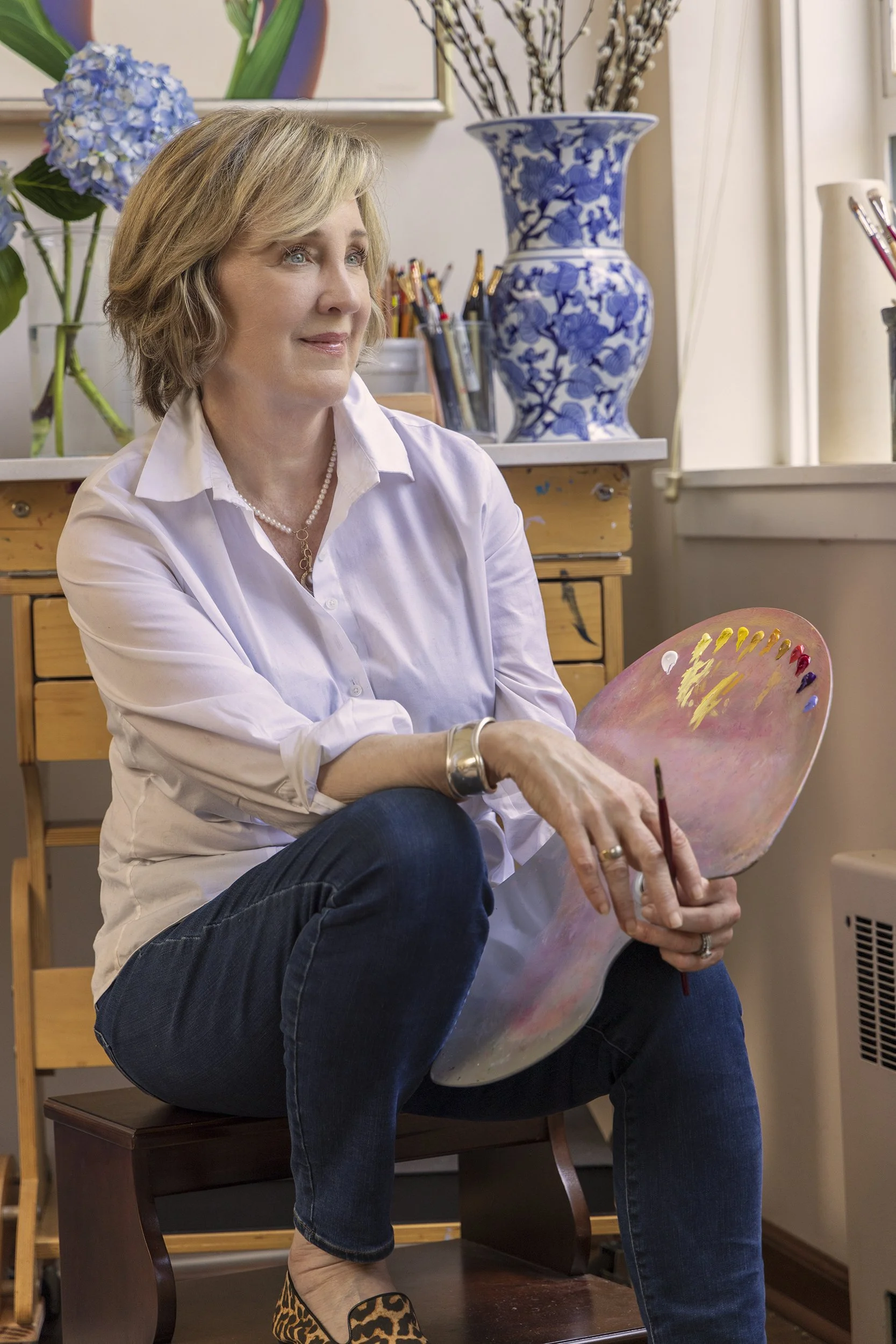BIOGRAPHY
Elizabeth Barlow grew up in Salt Lake City, Utah, in a house filled with art and surrounded by flower gardens. Her father was the late artist Philip Barlow, and after a detour in the performing arts, she followed his inspiration back to painting. Barlow earned her BA at the University of Utah, and Masters’ Degree from the University of Virginia. After some years living abroad, she relocated to the San Francisco Bay Area, where she continued her arts education at UC Berkeley Extension. There she studied drawing and painting with Donald Bradford and others, earning a Post-Baccalaureate Certificate with Distinction in Visual Arts. In 2007 she studied in New York City at the Art Students League.
A contemporary still-life artist, Barlow follows a time-honored practice. She begins by making a pencil sketch of her subject on an oil-primed, custom-made linen support. She follows this with an alla prima (initial wet on wet) layer of oil paint in color. Multiple glazed layers follow, a meticulous and time-consuming process that results in works of luminosity and depth. To develop her composition she takes hundreds of photographs to use as her references, later combining them to realize the vision she is after.
In her San Francisco studio, Barlow devised an innovative approach to portraiture, her favorite genre of painting. In collaboration with her subjects, she composed arrangements of their most meaningful possessions. She documented personal items such as jewelry, favorite clothing, books, and a variety of precious keepsakes. With an intimacy more characteristic of ordinary portraiture, these still lifes exhibit a powerful presence. Although she no longer creates them, the Portraits in Absentia series was well-received and exhibited often.
With her move to the Monterey Peninsula in 2016, Barlow’s work underwent a transformation. Finding herself immersed in sea air and surrounded by forests and year-round flowers, she was inspired to take nature as her subject. In response to a commission, Barlow began to paint flowers, which led to her current series, Flora Portraits. She sees flowers as potent symbols of life force, of strength within fragility, and of the power of re-emergence that lies within all living things. With the support of her daily meditation practice, she believes that painting flowers is a transformative practice that allows her to slow down, look deeply, and develop a deep reverence for all living things.
Elizabeth Barlow is represented by Andra Norris Gallery in Burlingame, CA. Her work is held in public and corporate collections including the Monterey Museum of Art; San Francisco Opera, San Francisco, CA; the Lucille Packard Children’s Hospital at Stanford University, Palo Alto, CA; The Absinthe Group, San Francisco, CA; and the Community Hospital of the Monterey Peninsula, Monterey, CA. She gains inspiration from artists Georgia O’Keeffe, Martha Alf, Johannes Vermeer, Claudio Bravo, and David Ligare, but her father Philip Barlow remains her most revered teacher and principal artistic influence. In 2023, her work was featured in the exhibition Flora Fauna at the Monterey Museum of Art.
ARTIST STATEMENT
In 2016, I moved with my husband from San Francisco to Carmel-by-the-Sea on California’s central coast. Suddenly, my world was suffused with trees, flowers, mists, and soft sea breezes. This verdant environment brought back memories of my childhood and led to a new trajectory in my work. I began a series called Flora Portraits, in which I depict flowers at many times their life size and set them in spare, monochromatic backgrounds. I work in oil on fine French linen in a slow process that requires many glazed layers to achieve the rich and luminous result I want. For each painting, I gather flowers, leaves, branches, and vines and bring them into my studio. There, I arrange them in dramatic lighting and photograph them. Over a period of many hours and even days I construct a composition that expresses the story I wish to convey.
I am primarily a still-life artist, but I think of these Flora paintings as portraits. They are portraits of individual flowers in their ephemeral place and time, and in their characteristic forms and colors. I am not seeking to create scientifically accurate depictions. Although they are representational, I seek to highlight the individual character and energetic essence of every bloom I portray. Because my process is slow and meticulous, each painting brings with it a way of slowing down and paying careful attention, something that is hard for most of us to do in our distracting digital age. I have discovered that painting the intricate details of a flower is a meditation that promotes a deep reverence for all living things. Slow, careful looking gives us a chance to awaken to the beauty that is around us, and attending to beauty can be a transformative practice. Fully witnessing the beauty of a flower will generate awe and respect, and lead to respect for all the natural world. If we cannot treasure life on this planet, how can we care for it?
At one time women painted still life because it was the only subject they had access to. Today, I paint flowers because they are potent symbols of the incredible power of the life force on this earth, of strength within seeming fragility, and of the astonishing ability for rebirth and re-emergence that lies within all living things. I want my paintings to be a call to see and pay attention to beauty because it will transform how we walk through this world. By slowing down and looking at things deeply – in my case, by painting flowers – we develop a deep reverence for the living things on this planet and we awaken to the wonders of our precious home.



